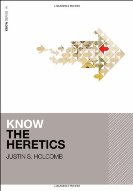A Brief Book Summary from Books At a Glance
About the Author
Justin S. Holcomb is an Episcopal priest and teaches theology at Gordon-Conwell Theological Seminary and Reformed Theological Seminary
Table of Contents
Introduction: Why Heresy?
Chapter 1
Judaizers: The Old Rules Still Apply
Chapter 2
Gnostics: God Hides Messages for the Enlightened
Chapter 3
Marcion: Vengeful Yahweh versus Gentle Jesus
Chapter 4
Docetists: The Spiritual is Good, the Physical is Evil
Chapter 5
Mani: God Must Be Freed
Chapter 6
Sabellius: One Actor and Three Hats
Chapter 7
Arius: Jesus Is a Lesser God
Chapter 8
Apollinarius: Christ May Be Human, but His Mind is Divine
Chapter 9
Pelagius: God Has Already Given Us the Tools
Chapter 10
Eutyches: Christ as a New Kind of Being
Chapter 11
Nestorius: Christ’s Divinity Must Be Shielded
Chapter 12
Socinus: The Trinity Is Irrelevant and Jesus’ Death Is Only an Example
Conclusion
Introduction: Why Heresy?
In the first centuries of its existence the church had to grapple with the task of stating its faith with precision. Issues such as the person of Christ, his two natures, the Trinity, and the work of salvation are complex, and inevitably various theories arose [lack of understanding and misunderstanding] to compete for acceptance.
“Orthodoxy” (“right teaching”) is that teaching that follows Scripture and best summarizes its teachings, with all its mysteries and even its seeming paradoxes.
“Heresy” is teaching that deviates from “orthodoxy,” especially with reference to what are considered essentials or fundamentals of the faith. In the course of the decades and centuries after the apostles, differing explanations competed for acceptance, and the church was forced to study the Scriptures and provide exact statement of its teachings as the New Testament itself requires.
Scripture presupposes a right and a wrong interpretation of such things as Jesus, his coming, the nature and character of God, the gospel, and so on. It also speaks of “false doctrines and, by contrast, “the pattern of sound teaching.” The apostles were not hesitant to call out heresy when they saw it.
Even before the first “ecumenical creeds” the early church recognized the “rule of faith” – brief summary statements of essential Christian teaching by which new teachings were measured. In time this gave way to recognized creedal formulations and creeds.
An understanding of both truth and error are essential to 1) a right understanding of God as he has revealed himself, and 2) an acceptable worship of him.
Chapter 1
Judaizers: The Old Rules Still Apply
Historical Background
Christianity was born in the Jewish community, and so when in the infant church Gentiles came to follow Christ questions arose concerning their obligation to Moses’ law – especially whether they must receive the covenant sign, circumcision. Judaizers insisted that they must be circumcised to be saved….
[To continue reading this summary, please see below....]
The remainder of this article is premium content. Become a member to continue reading.
Already have an account? Sign In
